A Surreal Nebular Safari in the Southern Skies
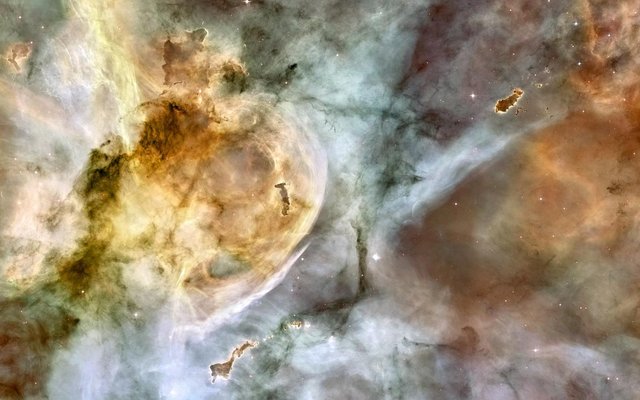
A lone ship stands guard on an oddyssey into an untamed maelstrom of birth and death. A shrouded celestial forge producing nearly uncountable numbers of stars that live fast and die young. Where starbursts with peculiar natives glitter like jewels and nebulae with equally shocking supernovas stun.
My son has a fascination with planets and space these days. At bedtime he wants to hear stories of trips into the stars, and I entertain him with tales of exotic destinations and fantastic adventures. On most nights its difficult to keep him in bed once tucked in unless I tell him at least one short story about expeditions to Jupiter and Arcturas.
To best engage the boundless imagination of a six year old, I have used Carina and it's acclaimed nebula as the setting for his bedtime stories. The Carina Nebula is like a beautiful treasure chest that once opened contains a bounty of intrigue. A vast playground of nebulas nestled inside of even larger nebulas, in which his mind can run wild imagining fanciful places such as Mystic Mountain and its cloudy pinnacles. I look at it as another tool in my arsenal to encourage his budding scientific interests where he can learn astronomy and excercise his creativity at the same time.
I'd like to take you on an oddessy of our own as we explore the neighborhood surrounding the Carina Constellation and dive into the depths of her Nebula.
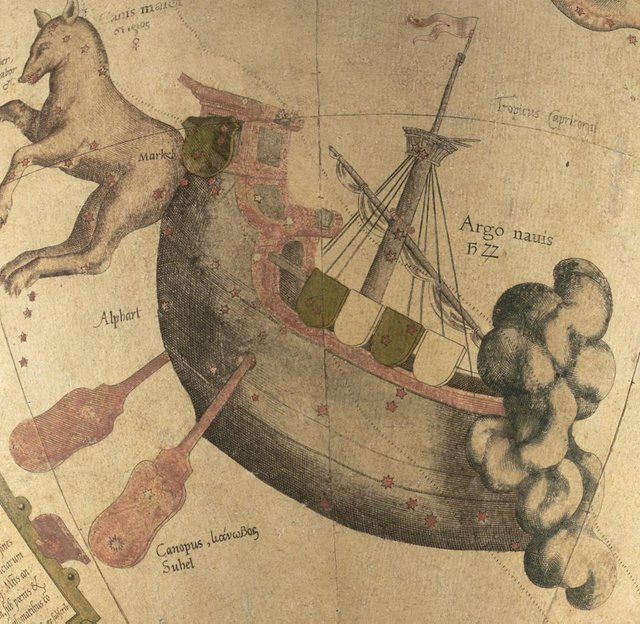
In the southern hemisphere there once was a mega constellation called the Argo Navis. Named after the Argo, a legendary ship Jason and his crew sailed in in the search of the fabled golden fleece, it dominated the south eastern sky until one day in 1763 a man by the name of Nicolas Louis de Lacaille must have decided that the Argo Navis was just too damned big and broke it down into the three smaller constellations of Vela, Puppis and Carina. Vela being the Argo's sail. Puppis its stern and Carina its hull. The ship lays anchored in the night sky just off a lucent celestial reef of cold dust and hot gas. The inhabitants of which, have attracted the intense study of astronomers, giving them insights into the cycles of star formation, and stellar death.
The constellation its self sits just above the constellation Crux more commonly known as the Southern Cross. Carina starts high in the sky at the bright whitish-blue star Canopus and stretches down as if reaching for the Southern Cross until it then juts to the right at a cluster of faint but distinct blue stars known as IC-2602. From there it loops up and back towards the main shaft of the constellation again. Its overall shape is vaguely like a fish hook or maybe a warped and mangled lower case letter "b."
Canopus is nearly impossible to not notice as it will literally be the biggest and boldest star in the sky looking south and is the second brightest star in the entire night sky anywhere after Sirius. Canopus is named after the pilot of the ship in Greek legend that was sent to rescue Helen of Troy.
IC-2602 goes more frequently in astronomy circles by the name "The Southern Plieadies." This is just its nickname however, and should not be confused with the actual Plieadies found in the opposite direction in the night sky. We will revisit IC-2602 later in this article as it is good viewing through binoculars.
In the patch of sky between "The Southern Plieadies" and the "Southern Cross" lies the Carina Nebula, a home to more than 14,000 stars. Its visible even with binoculars as a fuzzy patch of light just below the "Southern Plieadies." If your having trouble finding Crux or Carina there are many apps and websites to help you find them. The following website works well for finding most things in the night sky. https://www.timeanddate.com/astronomy/night/
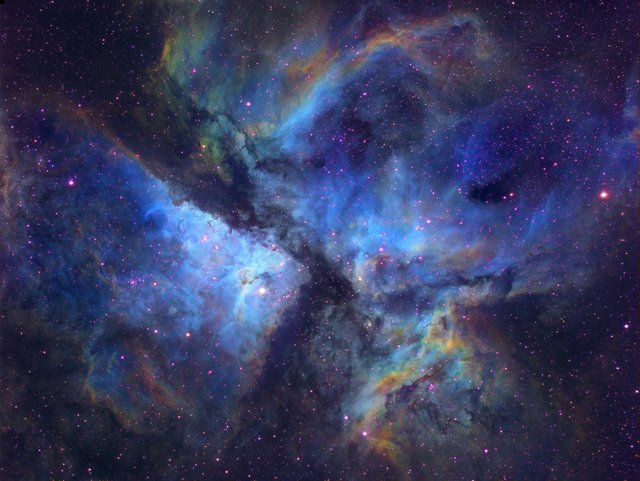 Shot of Carina Nebula in narrowband filter to highlight the ionized oxygen being blown into deep space by the hot stars in its core. The oxygen here is featured as blue, while the greenish red areas at the extremities are hydrogen. Most shots of Carina are generally reddish-magenta in hue as that is the natural colour of ionized hydrogen. See later photos in this article for an example.
Shot of Carina Nebula in narrowband filter to highlight the ionized oxygen being blown into deep space by the hot stars in its core. The oxygen here is featured as blue, while the greenish red areas at the extremities are hydrogen. Most shots of Carina are generally reddish-magenta in hue as that is the natural colour of ionized hydrogen. See later photos in this article for an example.
Located 8,500 light years away and 460 light years across the Carina Nebula is four times bigger and five times farther than M42 the Great Orion Nebula I covered in my last post. It resembles three triangles wedged together with the most acute and brightest of the triangles housing the nebulas core centered around the massive star Eta Carinae. The brightest of the triangles with the core is occasionally refered to as the Keyhole Nebula. Although technically its not correct as the keyhole bit is in reference to a smaller nebula located inside near the core called the Keyhole Nebula, which is named after its distinctive shape.
The southern part of the nebula below the core is often refered to as the "South Pillar" region due to the immense structures of dark interstellar dust found there. Although generally impenetrable without infrared due to the thick dust, there is much activity related to star growth found inside the South Pillar region. Later we'll view a shot of this region in infrared where it will look nearly unrecognizable compared to the photos of it in the visual spectrum. However, you will clearly see the nacient young stars forming.
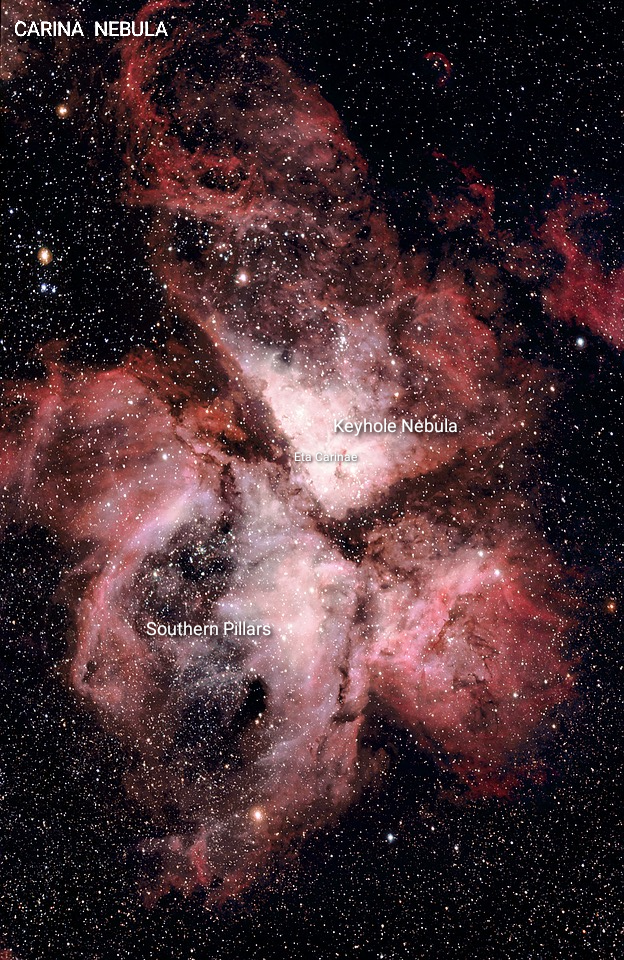
At the core of the Carina Nebula is that massive star system Eta Carinae. Its dominated much of the nebulas recent development and is probably one of the wildest stars astronomers know of and for many reasons which you'll read about shortly. Eta Carinae gives off tremendous solar radiation. Consequently much of the nebulas dust is being blown and sculpted by the stars output, similar to the manner in which water or wind would erode and shape landscapes.
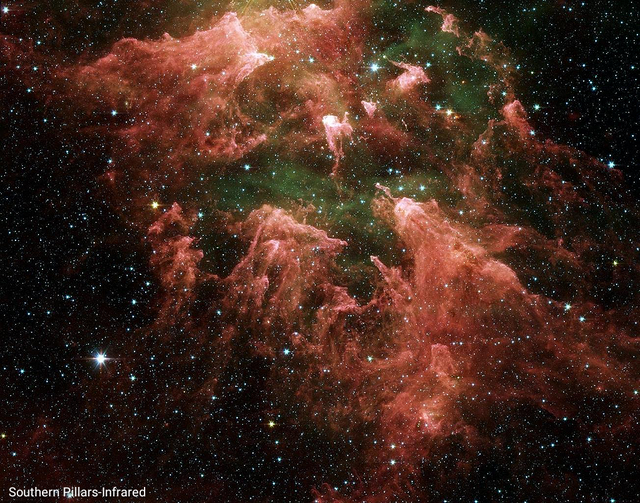 An infrared shot of the Southern Pillars. The baby stars appear yellow surrounded by pink dust while the hot interstellar gasses are seen as green. The blue stars are in the foreground of the shot and not part of the actual nebula. Just out of the shot near the top would be Eta Carinae. Notice the dust pillars are being blown like a comets tail away from the direction of Eta Carinae and the powerful solar wind and radiation it emits
An infrared shot of the Southern Pillars. The baby stars appear yellow surrounded by pink dust while the hot interstellar gasses are seen as green. The blue stars are in the foreground of the shot and not part of the actual nebula. Just out of the shot near the top would be Eta Carinae. Notice the dust pillars are being blown like a comets tail away from the direction of Eta Carinae and the powerful solar wind and radiation it emits
A behometh 150 times the size of our own sun, Eta Carinae is essentially the bad girl of the galaxy. And like most bad girls shes got a friend that tags along. Therefore, Eta Carinae is a binary system. Her partner star is a fairly big O type star at 50 to 70 times bigger than our sun. This star resides in an escentric orbit similar to Pluto where it strays far from her partner before swooping back in performing a close flyby. And when the two do get real close the neighborhood gets buffeted by intensly powerful solar winds howling at up to 6 million mph. To mix up the scene even more, sometimes the x-rays produced by the interactions of the two stars on each pass are quite erratic. On one pass they might make heaps and on the next go around produce far less and scientists aren't quite sure why.
Currently Eta Carinae holds the title for the brightest known star in the entire Milky Way galaxy. Just how bright is she? 4,700,000 times as bright as our own sun. And to add to her achievements shes the only known star that emits ultra violet lasers. It's as if the universe watched too many Austin Powers films and demanded. "All I want is a fricken star with a death laser! Is that too much to ask?" And what a laser at that. It's many times brighter than our own sun. Whats causing the laser is equally as wild. Hint...it has something to do with fact she's also a bit bipolar. But, we'll segue into that in just a bit. First I need to explain the rollercoaster ride of a recent history Eta Carinae has had.
Much like Orion's Betelgeuse, Eta Carinae is expected to blow pretty darned soon. Some even believe in our life time. Like a rock star, Eta Carinae is living fast and hard. She's only 3 million years old and already in her death throws. Compare that in consideration of our own sun which is 4.6 billion ears old and will keep going for another 5 billion. I guess us earthlings got lucky with our goldilocks of a star that wasn't too small or too big, too hot or too cold.
Eta Carinae may be the brightest star in our galaxy, but she hasnt always been. Before 1837 she wasn't in the top spot. But in that year she suddenly started flaring up in brightness and then in 1856, just as quickly as she started, dimmed mysteriously to being nearly unobservable. Then again in 1892 she suddenly became very bright again briefly before she proceeded to dim once more.
Scientists realised the flaring up Eta Carinae was exhibiting corresponded to the massive star sloughing off and ejecting its outer layers. Something like mini supernovas, and the end for Eta Carinae was very near. Finally in 1940 she turned on the lights again and hasnt stopped growing in intensity to this day, as if ramping up for something big. And we all know what that something is...a massively violent supernova. So violent in fact, that the burst of light will be visible on Earth even during the daytime.
Here's where the lasers tie in to Eta Carinae's history. In the first flare up in 1837 now nicknamed "The Great Eruption," Eta Carinae blasted 30 percent of her mass into two stupendous fireball looking shells of very hot florescent gas that are steadily expanding outward at 1,500,000 kph. The massive eruption looks like the Death Star exploding and it is truly spectacular. The two bulbous lobes are radiating out from each of the stars polls. The term is called bipolar outflow. However, sandwhiched in between both of them is a ragged skirt of heavier elements the star ejected during the eruption that are being flung from the stars equator. This skirt contains a lot of ionised iron and it's from that stellar vehemence that the intense ultra violet laser beams form.
This eruption is considered in its own right a nebula named the Homunculus Nebula. And it encases entirely Eta Carinae. When you look at images of most nebula you assume that they took eons to form, but Homunculus only took five years. One of its lobes is facing generally towards earth while the other facing away. Because of this the lobe expanding in our direction is blue shifted in hue while the other racing away is red shifted. What you see in photos of Homunculus is literally the actual explosion. One day it will eventually dissipate into the more soft and amorphous form we tend to think of nebulas as looking like. But before then, in about ten years time, Eta Carinae is expected to grow so bright that spotting Homunculus through the star's glare will be very difficult for astronomers.
 Boom!
Boom!
As spectacular as Eta Carinae is, it's just the tip of the iceberg when exploring the Carina Nebula. So much more is going on just below the surface of this nebula.
There is a place called Trumpler 15 near the outskirts of the nebula, where NASA's Chandra X Ray telescope has detected the remnants of dozens of supernovas from massive stars that, like Eta Carinae, lived fast and died hard. No less than six of these stars have collapsed down into ultra dense neutron stars. Neutron stars are second to black holes when it comes to being the densest objects in the universe. These former stars that were once 30 times the mass of our sun have collapsed down into spheres only 20 kilometres in diameter. Essentially neutron stars are failed black holes, limited by the fact their former selves just weren't quite big enough to go all the way through the process.
Scattered like lonely islands throughout the Carina Nebula you'll notice in pictures dense black clouds of stellar dust called Bok Globules. Named after the alliterative Bart Bok who first observed them back in the 1940s, Bok Globules are cocoons for young fledgling stars and serve as little private stellar nurseries for them. These Bok Globules being dense and cold are like harbours protecting the delicate young stars from the harsh solar winds and radiation that might otherwise strip them of the vital material they need to continue growing.
Interestingly, its believed that most of the stars formed inside Bok Globules are actually binary, triple or even more, star systems. Another interesting tidbit about Bok Globules is that some scientists believe its possible our sun and solar system of planets may have formed from a similar Bok Globule in our local region of space. Furthermore, some of the Bok Globules observed in the Carina Nebula are so small that they believe individual planets without any parent stars are forming in them. Eventually they will become rogue planets adrift in interstellar space.
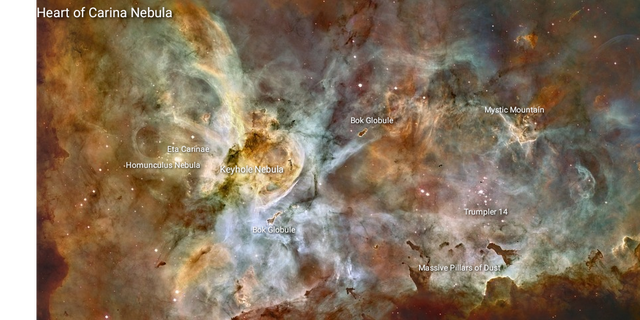 A general guide to the core region of the Carina Nebula. Trumpler 15 is located just out of shot on top of photo.
A general guide to the core region of the Carina Nebula. Trumpler 15 is located just out of shot on top of photo.
Located within the core of the Carina Nebula above a region called Trumpler 14 is a nebula that looks like it was inspired by J.R.R Tolkien. If Homunculus was the angry bad boy in Carinas life then this next nebula is definitely the coolest character in the neighborhood.
In February of 2010 the Hubble Telescope gave its self a 20th anniversary present by being the first to photograph a recently discovered feature inside the Carina Nebula scientists have named Mystic Mountain. Standing three light years tall and with several peaks, these spires of dust resemble a fantasy depiction of a mountain complete with misty clouds weaving amongst the pinnacles and embryonic stars forming at their apex.
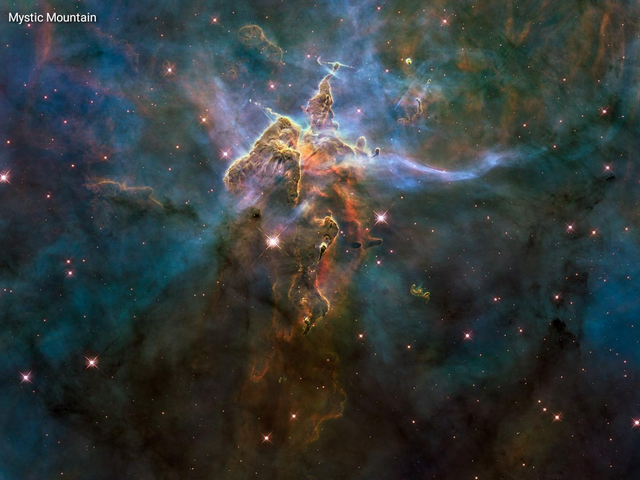
Closer examination of these proto stars forming at the apex of Mystic Mountain's pinnacles will reveal whats known as Herbig-Haro objects. These are jets of plasma that stream from the forming stars poles and then interact with the surrounding dust of the nebula. These young protostars still have a accretion discs at their equators of material swirling around them. Slowly the matter from these discs are getting pulled into and devoured by the coalescing protostars feeding their growth. These Herbig-Haro objects actually help ensure the stars survive the formation process by shedding off excess angular momentum generated by these circumstellar discs that would otherwise tear the starlings apart.
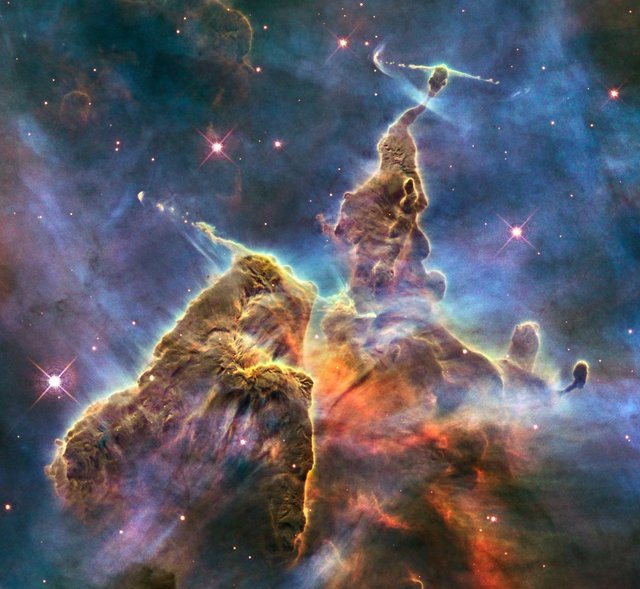 Close up of Mystic Mountain's Herbig-Haro Objects. Note the plasma streams jetting from each side of the protostars
Close up of Mystic Mountain's Herbig-Haro Objects. Note the plasma streams jetting from each side of the protostars
As with all things in the unverse, there is a balance between life and death. If one were to represent, in a theocratic sense, the Carina Nebula itself as Brahma the Hindu god of creation, and Eta Carinae the embodiment of Kali, her destructive eruptions of ejected matter to be used as fuel cycling rebirth. Then Trumpler 14, a star forming region just below Mystic Mountain, would represent Vishnu.
Glittering like diamonds, Trumpler 14 is one of the most heavily studied regions in space by astronomers who are interested in observing young and developing stars. Being one of the largest stellar nurseries in our galaxy she packs 2000 stars that average only 300,000 to 500,000 years old into a space 6 light years in diameter. That's a lot of stars packed into such a small place. For perspective on just how tightly these stars are clustered, our nearest star Proxima Centauri is 4.2 light-years away.
Places like Trumpler 14 are known as whats called Starburst regions. Basically places where inordinate numbers of stars are birthed at rates far above average. These hungry kiddos also are eating their way out of house and home gobbling up much of the interstellar dust and gasses surrounding them.
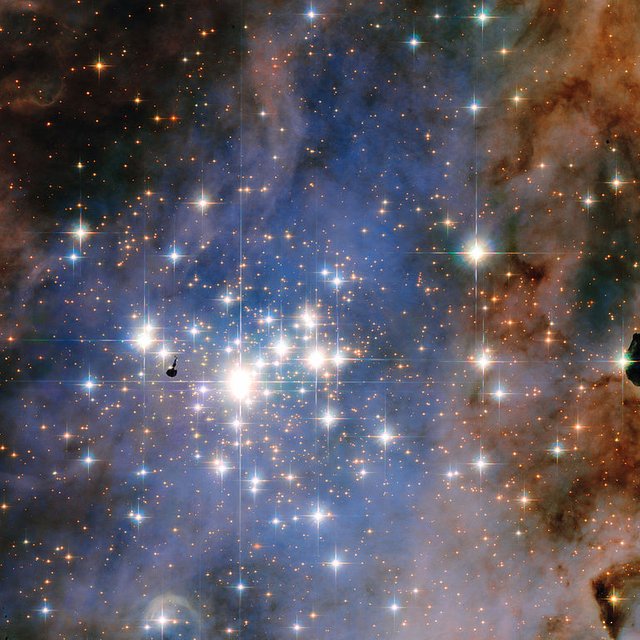 Close-up of Trumpler 14's young stars forming. Note the lone Bok Globule floating on the left like a silent derelict space craft
Close-up of Trumpler 14's young stars forming. Note the lone Bok Globule floating on the left like a silent derelict space craft
With all these energetic stars in one congested place, the collective solar winds they emit cause havock on the neighboring dust pillars just beyond them aggressively shaping them. And what will become of all these hard charging, fast living stars? Yep, you guessed it! Like a festive string of fire crackers on chinese new year they will mostly all go supernova and start a new cycle of rebirth. The view by astronomers will be amazing.
As spectacular as she is, Trumpler 14 has a bigger brother just outside the Carina Nebula. Located in the night sky just below the Carina Nebula and above the constellation Crux is the less well known nebula NGC-3603.
NGC-3603 is nearly 20,000 light years away. Much further than the Carina Nebula and is not only the largest H II region (cloud of ionized hydrogen) in our entire galaxy, but also the largest starburst in our galaxy.
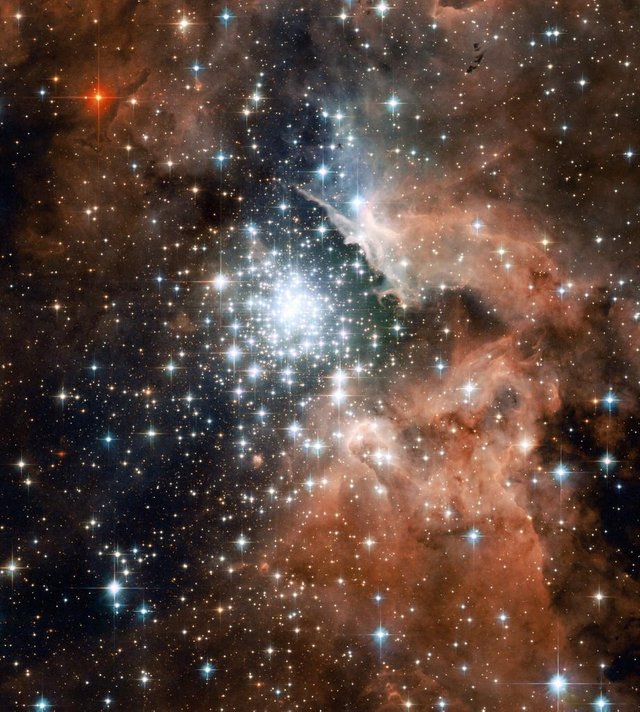
NGC-3603
One particular star in NGC-3603 has garnered a lot of attention and study. Near the fringes of the nebula astronomers discovered Sher 25. Sher resembles the Homunculus Nebula by having a faint hourglass like eruption, however instead of an equitorial skirt of ejected matter she's got a unusual circumstellar ring thats slowly expanding. This star is helping to shed light on what could have happened to another puzzling star named SN-1987A, found in the Large Magellenic Cloud, a dwarf galaxy hovering just beyond the edge of our Milky Way galaxy.
SN-1987A has a strikingly similar ring around it but scientists weren't exactly sure how it formed the way it did. At first they thought this type of ejection occurred when stars similar to Sher 25 and SN-1987A were cooling down from their red supergiant stage. But now with the study of the spectral emmissions from Sher 25, and the copious quantities of nitrogen and oxygen found, its believed that these types of eruptions must have happened during the stars blue supergiant phase earlier in its lifecycle. A curiosity indeed. Below are images of both Sher 25 and SN-1987A. As you can see SN-1987A took the whole ring thing to a whole new level. And just to clarify again. SN-1987A is not located in the Carina Nebula but in the Magellenic Clouds and is referenced as a tie in to the story of Sher 25. The Magellenic clouds, also fairly easy to view from the southern hemisphere, will likely be one of the subjects of next weeks post.
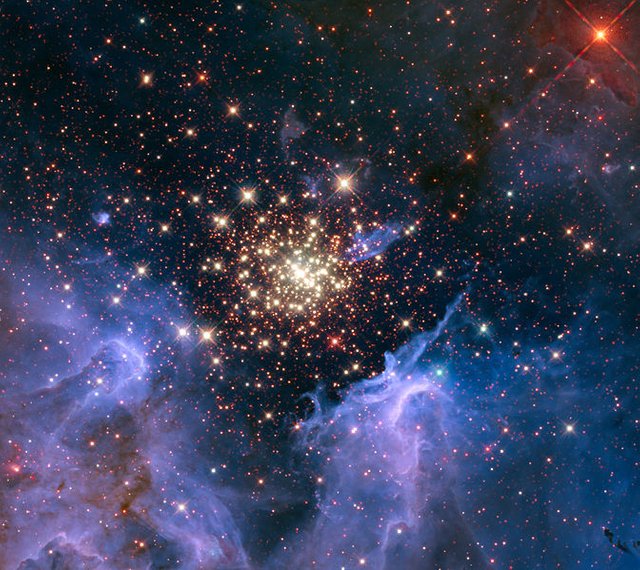
Sher 25 located in the right corner of the star cluster. Note its circumstellar ring nebula
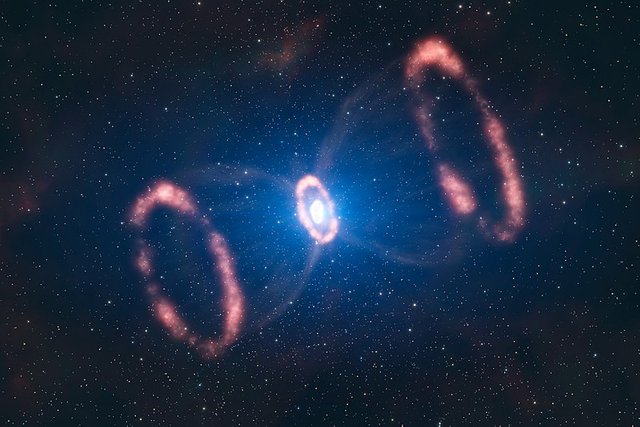
Artists impression of SN-1987A found in the Magellenic Cloud
Credit; ESO/ L. Calçada
Located down and a hair to the left of the Carina Nebula looking through a basic telescope or even a pair of good binoculars you can find NGC-2808 a globule cluster of stars. Looking through either it will look like a simple yellowish smudge. But just know that you are actually looking at this!
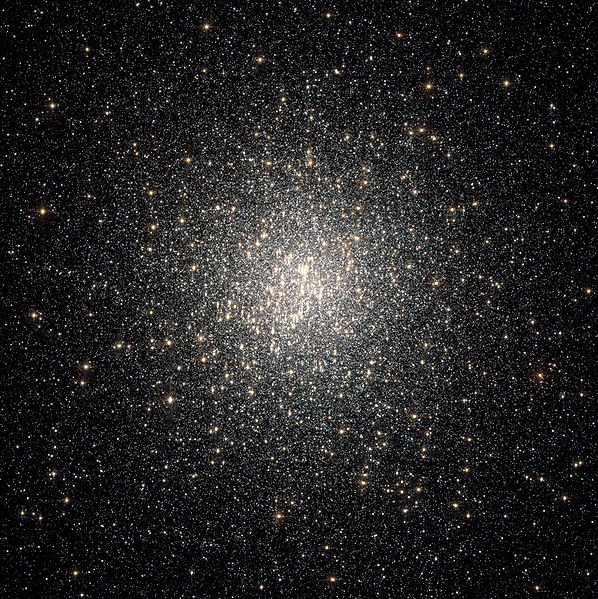
With over a million stars inside of NGC 2808 and over 12 billion years old its one of the largest collections of stars inside the Milky Way. So big a collection that some scientists think she may be the left overs of a dwarf galaxy similar to the Magellenic Clouds called the Sausage Galaxy (I know, I know. I dont make the names folks) that collided and became partially assimllated with our own. They believe its possible NGC-2808 may actually be the dwarf galaxies old core. So, although shes not particularly exciting to view through most home rigs its worth it just by the virtue of what it actually is.
Although I dont have a photo of the next object, worth mentioning and excellent viewing through a pair of binoculars is IC-2602 the "Southern Plieadies." If you read my prior post on Orion and managed to view the hilt of Orion's sword NGC-1981 than this will be very similar. It looks like a spattering of blue gems in the sky. Even with the naked eye the "Southern Plieadies" is easy to spot a bit above the "Southern Cross." In fact even without the Southern Cross in view (may be behind trees or houses, as its low on the horizon until 10pm this time of year) its easily spotted just by looking south.
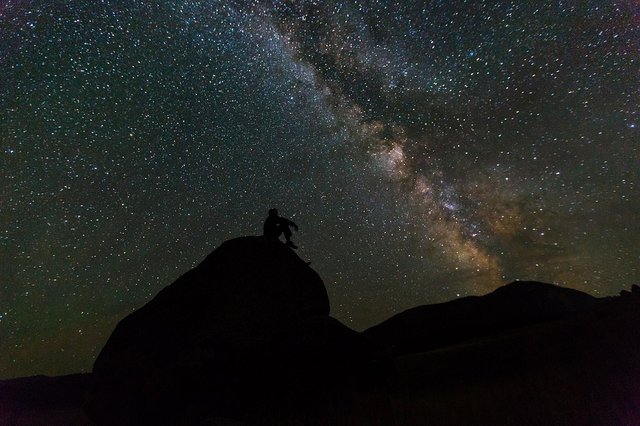
In our hectic day to day lives its often hard to stop and take notice of the universes hidden gems, like how in an inconspicuous "empty" little patch of night sky a gloriously surreal safari filled with unfathomable beauty is there just waiting by to be appreciated. A place who's rarely heard story of creation, destruction, rebirth and odd characters beckons to anyone daring to take a gander. If you have the fortune to live in the southern hemisphere and happen to look south one evening and catch the Southern Cross or Carina blazing in the night take a moment to have a second look in between the lines and realise that not all is as it seems and that theres always much more than meets the eye.
Its now 9pm as I write this and have just checked on my son in his room. I find him fast asleep nestled in a pillow fort on the floor and the projector softly lighting the ceiling overhead with images of the space shuttle and an astronaut. A placid smile is on his face and I can only hope that he's off dreaming about soaring through Mystic Mountain's whispy nebular clouds on his own cosmic adventure and making discoveries all his own.
I hope you enjoyed this tour of the Carina Constellation and her myriad of wonders.
Now to figure out where to take us next week.
The photos presented are CC0 and were provided by the following sites. It was almost as big a task scouring the internet finding these photos as it was writing this piece. I think I spent at least two days looking for usable images.
Pixabay.com
Unsplash.com
Free-images.com
Deography.com
http://deography.com/oxygen-in-the-great-carina-nebula/
NASA/ESA/Space Telescope Sciance Institute via Wikipedia.com
https://en.m.wikipedia.org/wiki/Sher_25#
https://en.m.wikipedia.org/wiki/Trumpler_14
https://en.m.wikipedia.org/wiki/NGC_2808
https://www.eso.org/public/news/eso1032/ via CC3 attribution. Photo has not been altered per accordance with CC3 rules.
Many of the pixabay and unsplash images were further edited with informational text added by author steemydave.
Special thanks to Steem member @astrophoto.kevin for his advice finding CC0 images for this project and for recommending deography.com. Furthermore, I'd like to extend my thanks to Dylan O'Donnell who owns deography.com and allows his photos to be used for CC0 usage. His work is superlative and I highly recommend readers check out his site. You may just find the next desktop image for your computer or tablet you've been looking for. In fact while you're at it head on over to @astrophoto.kevin who does his own gorgeous astrophotography and is very much worth checking out too.
An awesome post @steemydave
The reading really captivated me, especially since it is about the night sky of the southern hemisphere, which I would never see from the northern hemisphere.
Thank you very much for the mention :-)
Thanks Kevin! I'm glad you liked the post. It wouldn't have been as good if you hadn't directed me to those sites.
I spent most of my life in the northern hemisphere. Its just recently that I've made the change to the southern hemisphere. Its fun exploring a new sky. The town I'm in is very rural and we live on the outskirts so there is very little light pollution.
Thank You @cardboard. Very appreciative of the tipU vote. 😀
Congratulations @steemydave! You have completed the following achievement on the Steem blockchain and have been rewarded with new badge(s) :
You can view your badges on your Steem Board and compare to others on the Steem Ranking
If you no longer want to receive notifications, reply to this comment with the word
STOPVote for @Steemitboard as a witness to get one more award and increased upvotes!
I cam across your post too late for a resteem, so I have bookmarked it.
I would say your son is a very lucky lad, as not many fathers worry about opening the minds of their children to the wonders of our universe - since they themselves are wilfully blind to them. That you are teaching him to think for himself and to exercise his imaginations are far more than side effects. Now you will have to learn how to counter the indoctrination teachers fall back on, instead of attempting to teach, so that you preserve the places in his mind that glow with the miracle of learning and being able to wonder...
Hi Arthur!
Thanks for the comment. I like to think that I'm planting seeds in his head that will continue on their own as he grows himself. Kids often find interest in and emulate their parents interests when they're young. Im trying to make it so science is normal, natural and of enough interest that his own curiosity can propel him forward. There's a satisfaction one can get from discovery and learning about how fascinating and sophisticated the universe really is.
Schools often teach rote only memory and fail to instill that sense of wonder. And I think its important to supplement a childs education by exposing them to things outside of school and having them learn through that. Nature walks with a little lesson of biology thrown in or a night looking at the stars. A childs vegetable garden etc. All things I'm implementing.
Luckily hes a fairly independent kid. Mentally and physically its one of his core strengths. He's bright too so getting him to think for himself is no problem. Guiding that intellect to think constructively and beneficially for him as a personality trait that allows him to look beyond the box and continue growing even as an adult is the goal.
Thank you again for stopping by to read my post. And i look forward to chatting again in the future.
To listen to the audio version of this article click on the play image.

Brought to you by @tts. If you find it useful please consider upvoting this reply.